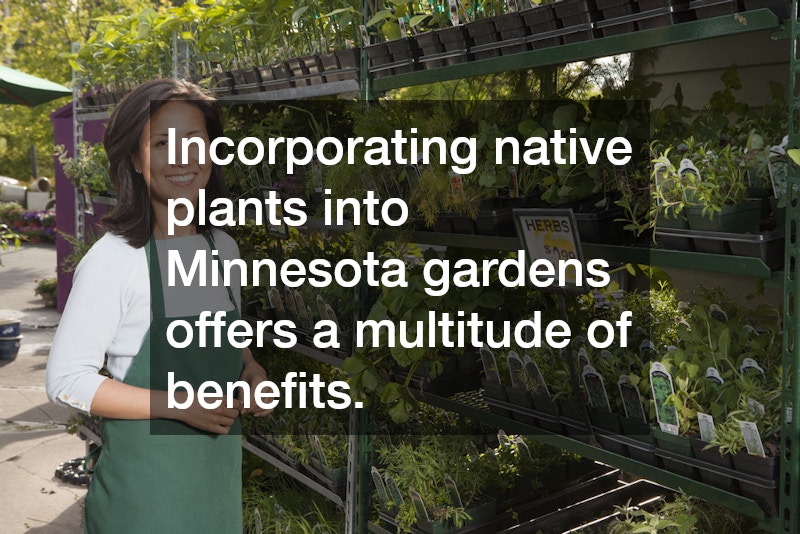Native Plant Landscaping: Key Species that Thrive in Minnesota Gardens
Learn why native plant landscaping is beneficial for Minnesota gardens and discover which species thrive in this locale.
What are the Benefits of Using Native Plants in Minnesota Gardens?
Environmental Advantages
Native plants are crucial in supporting the local ecology by providing habitat and food for local fauna, including pollinators such as bees and butterflies. By selecting plant species native to Minnesota, gardeners can help bolster local ecosystems, contributing to biodiversity and resilience against non-native pests and diseases.
These plants are adapted to local climate conditions, meaning they require fewer resources such as water and fertilizers, which decreases pollution and runoff. In addition, they help build soil health and stabilize landscapes with their deep-root systems, reducing soil erosion.
The incorporation of native species in home gardens also aids in the conservation of native birds and beneficial insects that rely on these specific plants for survival. This ecological synergy extends beyond individual gardens, contributing positively to the larger environmental landscape of Minnesota.
Economic and Low-Maintenance Benefits
Native plants in Minnesota gardens are economically advantageous as they often require less water, reducing reliance on irrigation and lowering water bills for homeowners. Because these plants are naturally suited to their environment, they also need fewer chemical interventions such as fertilization and pest control, saving money and reducing chemical exposure to the environment.
The adaptability of native plants to local environmental conditions means less effort is needed in their upkeep, making them a low-maintenance option for gardeners. Their natural defenses against local pests and diseases further decrease the need for intensive care.
Alongside reduced maintenance efforts and costs, native plants often steadily outperform non-native varieties, improving garden aesthetics and overall plant vitality. This combination of economic and aesthetic benefits makes them a popular and responsible choice for Minnesota gardeners.
How to Choose the Best Native Plants for Your Garden?
Understanding Minnesota’s Climate and Soil
Minnesota’s climate is characterized by cold winters and warm summers, demanding plant species that can withstand temperature extremes. Precipitation varies across the state, which gardens must account for when choosing native plants to ensure appropriate moisture requirements are met.
Soil composition in Minnesota also varies, including sandy, loamy, and clay-heavy soils. Understanding these differences is crucial, as native plants will be most successful when matched with compatible soil types to optimize growth and resilience.
A thorough analysis of soil drainage, nutrient content, and acidity is necessary for selecting the right species. This tailored approach enables gardeners to cultivate a thriving and sustainable landscape using native plants perfectly adapted to Minnesota’s climate and soil conditions.
Recommended Native Plant Species
Several native plant species thrive in Minnesota gardens, each suited to particular growing environments. The Purple Coneflower (Echinacea purpurea) is a popular choice due to its striking appearance and ability to attract pollinators while thriving in various soil types such as prairies and meadows.
Another versatile option is the Prairie Smoke (Geum triflorum), which performs well in sandy and loamy soils, providing stunning visual appeal with its unique plumed seed heads. This perennial is particularly drought-tolerant, making it ideal for areas with occasional dry spells.
Little Bluestem (Schizachyrium scoparium) is a native grass known for its low-maintenance requirements and eye-catching fall colors. These plants are ideally suited for open fields and hillsides across Minnesota, promoting biodiversity and soil health.
How to Successfully Maintain a Native Plant Garden in Minnesota?
Best Practices for Care and Maintenance
Consistent watering is crucial during the first establishment phase of native plant gardens, particularly within the first two growing seasons. Once established, native plants typically require minimal additional irrigation, relying instead on natural rainfall patterns.
Avoid over-fertilization, as excessive nutrients can promote the growth of non-native species at the expense of native plant health. Using organic mulch can help retain soil moisture and suppress unwanted weed growth, promoting a sustainable ecosystem.
Effective pest management focuses on maintaining biodiversity to foster natural predator-prey relationships, reducing the need for harmful pesticides. Encouraging birds and beneficial insects through strategic planting helps keep pest populations in check.
Community and Expert Resources
Gardening challenges can often be tackled with expert advice provided by local organizations and gardening clubs dedicated to native plant advocacy. The Minnesota Native Plant Society and regional University Extension programs offer resources and workshops to help gardeners succeed.
Online forums and dedicated websites provide platforms for exchanging knowledge and experiences among the gardening community, building a valuable resource network. These resources offer insights into plant choices, care techniques, and troubleshooting common issues unique to native plant gardening in Minnesota.
Collaboration and guidance from community experts ensure that gardeners can confidently implement native plant landscaping in their spaces. Engaging with these resources enhances not only individual gardens but also contributes to statewide environmental sustainability efforts.
Conclusion
Incorporating native plants into Minnesota gardens offers a multitude of benefits, from ecological and economic advantages to lower maintenance and enhanced biodiversity. By selecting and maintaining species adapted to local conditions, gardeners contribute positively to the environment and create resilient landscapes.
Through careful planning and access to community resources, native plant landscaping can transform spaces into vibrant, sustainable ecosystems. Embrace the natural beauty and functionality of native plants, and enrich both your garden and the broader environment in Minnesota.

